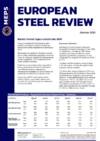Plus ça change
One year ago, large swathes of Europe were suffering from the aftermath of severe flooding. Transport routes were heavily disrupted, hampering supply of raw materials and finished steel goods. A shortage of truck drivers prevented a full-scale switch from river to road transport.
Steel mills, mainly by choice, had not fully restored production, following cuts introduced during the first Covid-19 wave. European domestic steel availability was at a low level. Nonetheless, necessary plant maintenance took place, as scheduled.
EU and UK safeguard measures had been extended, restricting access to imports.
Transport difficulties, tight supply and limited imports combined to support elevated steel product values. Solid margins provided the basis for “green” technological investment.
One year ago, automotive forecasts, for the second half of the year, were strong.
This summer, prolonged dry weather has reduced major European rivers to streams. Levels in the Rhine are as low as 30cm. Carrying capacity of barges is cut to around thirty percent.
At the same time, increased coal imports into Germany, via Antwerp and Rotterdam, to boost electricity generation, are exerting further pressure on water routes. Road transport still cannot fill the gap.
The impact of Covid-19 on industry has lessened, although there is concern for further disruption as winter approaches.
Steel producers are restricting production capacity, amid ongoing weakness in demand. Despite planned maintenance, mills are seeking orders as intake falls and delivery lead times reduce.
European safeguard measures remain in place. Ports, however, are full of imported steel, adding to stocks in the supply chain.
Elevated inventories, reduced demand and improved availability continue to exert downward pressure on prices. Mill margins are close to break-even, and some investments are on hold.
This summer, automotive forecasts, for the second half of the year, are strong.
The Russian invasion of Ukraine, in late February 2022, provided an immense shock to European steel prices, as long-standing supply routes disappeared overnight.
Unsurprisingly, panic buying caused a spike in transaction values. Once new sources became established, steel prices tumbled, dragged down faster by reduced demand.
The automotive industry is held by many to be the potential saviour of the steel market. Large mill volumes are destined, directly and indirectly, to vehicle manufacture.
Last year, output failed to recover, in the continued absence of semiconductors. Signs of a pickup are visible, but these are sporadic and regional in nature.
As ever, auto holds its cards close to its chest while steel suppliers hope for rapid improvement.

Source:
European Steel Review
The MEPS European Steel Review is an informative, concise and easy-to-use monthly publication, offering unique professional insight into European carbon steel prices.
Go to productRequest a free publication





